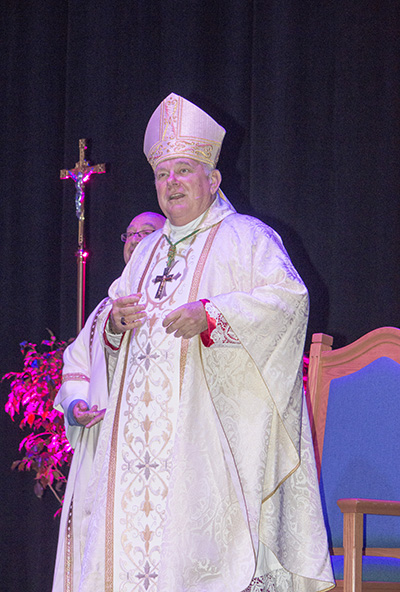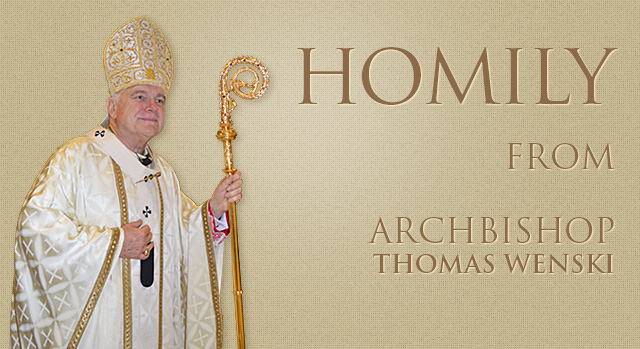By Archbishop Thomas Wenski - The Archdiocese of Miami
Archbishop Thomas Wenski preached this homily on the feast of the Assumption, Aug. 15, 2017, at a gathering of the archdiocese’s nearly 3,000 Catholic school teachers for the beginning of the 2017-18 school year.
Yesterday, I flew in from Philadelphia. Together with five of our seminarians, Father Elvis Gonzalez, our vocations director, Father (Richard) Vigoa and I participated in a four-day walking pilgrimage through back roads of New Jersey to the Marian Shrine of Our Lady of Czestochowa, in Doylestown, Pennsylvania. It was a trek of almost 60 miles, and it wasn’t easy. About 2,000 people participated – mostly Poles who continue here in America this tradition of their native Poland – but such a pilgrimage, in the heat and rain, sleeping in tents with no showers or flushing toilets (well, the seminarians and 2,000 pilgrims slept in tents; Father Vigoa, Father Elvis and myself commuted to showers and beds at the Shrine monastery each night) but such a pilgrimage – a kind of walking “retreat” – is undertaken precisely to remind ourselves that we all are pilgrims on this earth. Our vocation – the reason why we are put on this earth – is to journey to heaven. God, who created us in his own image and likeness, did not create us just to die one day but he made us for himself. To go to heaven is to go to God, to live with God.

Photographer: ANA RODRIGUEZ-SOTO | FC
Archbishop Thomas Wenski celebrates Mass Aug. 15 for nearly 3,000 archdiocesan elementary and high school teachers gathered for their annual back-to-school assembly at the Pembroke Pines City Center.
Today, we celebrate the day of Mary’s birth in heaven, and the end of her earthly pilgrimage. Pope Pius XII expressed the constant belief of the Church when in 1950 he solemnly defined the dogma of the Assumption of the Blessed Virgin Mary in these words: "…the Immaculate Virgin, preserved free from all stain of original sin, when the course of her earthly life was finished was taken up body and soul into heavenly glory, and exalted by the Lord as Queen over all things, so that she might be the more fully conformed to her Son, the Lord of lords and conqueror of sin and death.” (CC #966)
These words resonate with the words of
St. Paul in today’s second reading:
“For just as in Adam all die,
So too in Christ shall all be brought to life,
But each one in proper order:
Christ the first fruits;
Then, at his coming, those who belong to Christ.”
The trajectory of Mary’s life was always “God-ward.” Full of grace from the very moment of her conception, Mary Immaculate never ceased to grow in grace before God. Her pilgrimage did not know some of the detours or even U-turns that we sinners oftentimes take in our own pilgrimages. When we observe her at the various landmarks that outline the trajectory of her life’s pilgrimage, we see her always faithful, always moving forward, always straining towards God and seeking his will.
Today, in an era of heightened individualism and narcissism, the work that you embrace as principals and teachers in our Catholic schools is certainly not easy. And so we invoke Mary’s intercession; may her prayers help us to move the children entrusted to our care away from self-centeredness and to being more “God-centered.”
We educate these kids to equip them for their own life’s pilgrimage, through what is often a “valley of tears.” A solid Catholic education is not just about how to make a good living, to do well; it is about learning the ways of being good and living well. We want our students to excel – not just so that they can get into Ivy League Schools: W,e want them to get into heaven as well.
Catholic education, because it is based on the whole truth about the human person – our dignity and our destiny (in this world and the next) – helps to open the hearts of our young people wider and it helps to broaden the horizons of their minds so that there might be room for God in their lives – and room for others. The sacrifice of parents and our parishes to support Catholic education will be well worth the price if our young people’s existence is no longer “self” centered but rather directed towards others and to God. We teach values. We teach virtue. And as Jesus told a certain rich young man, “If you would have life, keep the commandments.” (Mat. 19: 17). We teach the commandments. In this way, as these young people make their way through life, they will not lack the road signs, the GPS coordinates that will keep them on the right path, the path that leads them to God. And remember, we can give these children everything but if we don’t give them God we give them too little.
With baptism, we are incorporated into Christ and come to share in his Risen Life. In the pilgrimage of risen people whom Christ brings with him to heaven, Mary goes first, with Christ and for Christ. But Mary’s vocation is the Church’s vocation. In the vivid imagery of the Book of Revelation, as the woman clothed in the sun, she represents us – and she precedes us.
The Assumption, then, celebrates Mary but also consoles us – for in taking Mary into Heaven body and soul God assures us that he keeps his promises. The affirmation we shall make in the Creed we recite is not just wishful thinking: “I believe in the resurrection of the body and life everlasting.” Such an affirmation of faith is believable; it is credible because it has been promised us by someone who is trustworthy. We believe in the promise because it is Jesus who has promised us; and, we believe because, in Mary, the promise already has been kept.
Mary never forgets she is the handmaid of the Lord, nor does she forget the gratuitous goodness of the Lord. And that we might not forget, her Magnificat closes the day in the Church’s evening prayers. Mary in heaven carries out a ministry of intercession on our behalf – ever in communion with her son. Although we are sinners, we commend ourselves full of trust to this mother of ours so that after our earthly pilgrimage we too might live in God.
Turn then, most gracious advocate,
thine eyes of mercy toward us, and after this our exile, show unto us the
blessed fruit of thy womb, Jesus.
O clement, O loving, O sweet Virgin Mary.
Pray for us, O Holy Mother of God, that we may be made worthy of the
promises of Christ.

